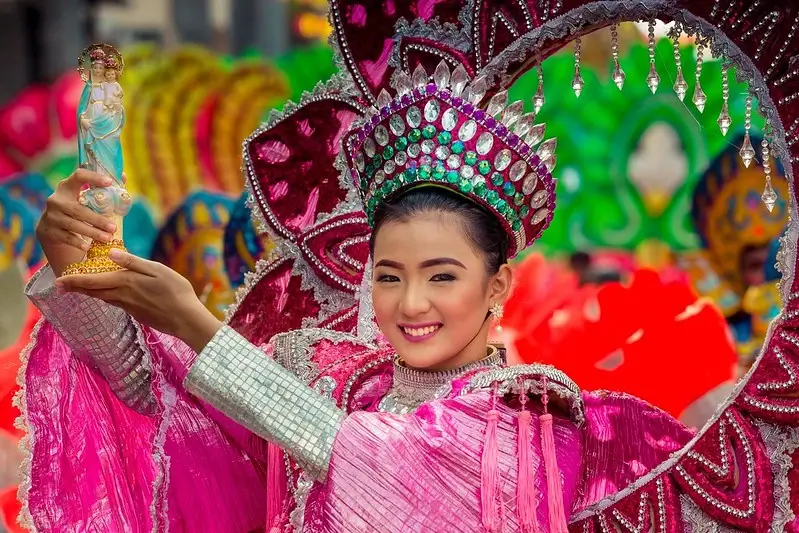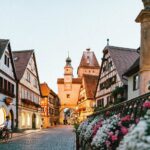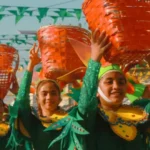Image Credit: Flickr
Experience the vibrant colors of Zamboanga during the Hermosa Festival. This month-long celebration is a display of the city’s rich history and devotion to Nuestra Señora del Pilar.
From its Spanish origins to the modern festivities, the festival captivates visitors from around the world. Join us on this journey through Zamboanga City and discover the heart and soul of Fiesta Pilar.
Key Takeaways
- The Zamboanga Hermosa Festival is vibrant in Zamboanga City, Philippines, showcasing the region’s culture, history, and tradition.
- The festival features events like the Vinta Race and Regatta, which highlight the evolution of the Vinta design and its impact on the coastal community.
- The preservation of the Chavacano language is of great importance within the Zamboanga Hermosa Festival, as it reflects the unique heritage and identity of the city and is embedded in various aspects of daily life.
- Fort Pilar, with its historical significance and architectural design influenced by Spain, plays a pivotal role during the festival, symbolizing the city’s rich past and resilience. It also acts as a center for ritual practices and grand processions.
Facts About Hermosa Festival Philippines
| Facts | Explanation |
|---|---|
| Name of the festival | Hermosa Festival |
| Type of festival | Cultural and religious festival |
| Festival Etymology | The word “Hermosa” means “beautiful” in Spanish, symbolizing the beauty and charm of the city and its people. |
| Brief history of the festival | The Hermosa Festival is an annual celebration held in the City of Zamboanga, Philippines. It originated in the early 20th century as a way to honor the miraculous image of Our Lady of the Pillar, the patroness of the city. The festival combines both religious and cultural elements, showcasing the rich heritage and traditions of Zamboanga. It features a series of colorful events, parades, dances, and street performances, attracting both locals and tourists alike. |
| Brief history of the city | The City of Zamboanga is located in the southern part of the Philippines and has a rich history influenced by various cultures and civilizations. It was once a thriving trading post during the Spanish colonial era and later became an important stronghold during World War II. Today, Zamboanga is known for its vibrant mix of cultures, including indigenous tribes, Spanish, Malay, Chinese, and Muslim influences. The city is often referred to as “Asia’s Latin City” due to its Spanish-influenced architecture, language, and traditions. |
| Ethnic information | Zamboanga is home to a diverse range of ethnic groups, including the Subanen, Tausug, Samal, Chavacano, and Yakan communities. Each group contributes to the cultural tapestry of the city, showcasing their unique traditions, music, dances, and crafts during the Hermosa Festival. |
| Location of the city | Zamboanga City is situated on the western coast of Mindanao Island in the Philippines. |
| How to reach the city | – By air: Zamboanga International Airport is served by domestic flights from major cities in the Philippines. – By sea: Ferries connect Zamboanga City to other islands in the Philippines. – By land: Buses and vans provide transportation services to Zamboanga City from neighboring provinces and cities. |
| Nearby and surrounding cities or towns | – Dipolog City (225 km) – Pagadian City (207 km) – Dapitan City (225 km) – Iligan City (211 km) – Cagayan de Oro City (255 km) |
| Google map link | Zamboanga City Location |
| Festival main events and activities | – Procession of Our Lady of the Pillar’s image – Street dancing competition showcasing various cultural dances – Beauty pageants – Traditional music and dance performances – Food fairs featuring local delicacies – Fireworks display – Art exhibits – Trade fairs showcasing local products – Sports competitions |
| Other famous tourist attractions in the city | – Fort Pilar – A historic fort that dates back to the Spanish colonial period. It houses a museum showcasing Zamboanga’s history. – Pasonanca Park – A picturesque park known for its lush greenery, swimming pools, and treehouses. – Great Sta. Cruz Island – Known for its pink sand beach and diverse marine life. – Merloquet Falls – A stunning waterfall located in a lush forest setting. – Yakan Weaving Village – A community known for its intricate traditional weaving techniques. |
| Famous food dishes of the city | – Curacha – A local delicacy consisting of a large crab cooked in a special sauce. – Knickerbocker – A refreshing mixed fruit dessert with ice cream. – Satti – Skewered meat served with spicy peanut sauce and rice. – Chavacano Pancit – A flavorful noodle dish influenced by Spanish cuisine. – Zamboanga Durian – Known for its distinct taste and aroma. |
| Landmarks in the city | – Zamboanga City Hall – The seat of government and a prominent landmark in the city. – Paseo del Mar – A waterfront promenade where locals gather for leisure activities. – Yakan Cultural Village – Showcasing the vibrant culture of the Yakan tribe through traditional arts and crafts. – Metropolitan Cathedral of the Immaculate Conception – A beautiful Catholic cathedral with architectural grandeur. – Zamboanga City Museum – Preserves artifacts and memorabilia related to Zamboanga’s history. |
| Related festivals in the same region | – Sinulog Festival (Cebu City) – Kadayawan Festival (Davao City) – Ati-Atihan Festival (Kalibo, Aklan) – Panagbenga Festival (Baguio City) – Pahiyas Festival (Lucban, Quezon) |
Understanding Zamboanga Hermosa Festival
In light of the Zamboanga Hermosa Festival, you must be informed about its cultural significance and vibrant traditions that make it a standout among Philippine festivals.
This spectacle’s origins date back to the 17th century, born from the community’s devotion to Our Lady of the Pillar. It’s a time when the city comes alive, adorned in pink, the color symbolizing unity and peace.
Community involvement is paramount, as locals and tourists revel in the dance parades, regattas, and exhibits showcasing the region’s rich culture and history. You’re not just a spectator; you’re part of the celebration.
Understanding this festival is understanding the spirit of Zamboanga – a spirit of unity, resilience, and freedom. Dive in, immerse yourself, and let the Hermosa Festival leave a lasting impression.
The Iconic Vinta Race
One of the highlights you can’t miss is the iconic Vinta Race. This thrilling spectacle showcases the area’s rich maritime heritage. This race is more than just a competition; it’s a testament to the Vinta Design Evolution and a reflection of the Coastal Community Impact.
You’ll witness:
- Colorful vintas, traditional boats with sails resembling a butterfly, racing against each other.
- The evolution of the Vinta design has adapted to modern needs while retaining its traditional essence.
- The impact of this race on the coastal community is fostering unity and preserving cultural heritage.
- The freedom and exhilaration felt by the sailors and spectators alike.
Don’t just watch this race; immerse yourself in the culture and history it represents.
Importance of Chavacano Language
You’ll discover the significance of the Chavacano language in the context of the Zamboanga Hermosa Festival and beyond. Your understanding of its preservation efforts, role in daily life, and cultural significance will be expanded.
This unique language isn’t just a form of communication but a vibrant symbol of the rich and diverse culture of Zamboanga City.
Chavacano Language Preservation
You’re playing a crucial role in preserving the Chavacano language every time you participate in the Zamboanga Hermosa Festival. This linguistic diversity is a cultural treasure, linking us to our rich history and unique identity. By using and promoting Chavacano, you’re helping to keep this language alive and vibrant.
Here’s how you can contribute more:
- Chavacano Media: Utilize local media platforms to highlight the use of the language.
- Education: Encourage the teaching of Chavacano in schools.
- Daily Conversations: Use Chavacano in your everyday communication.
- Online Presence: Share content in Chavacano on social media platforms.
Chavacano in Daily Life
Understanding the importance of Chavacano in daily life isn’t just about communication; it’s about embracing a cultural heritage that’s uniquely ours. It’s a bridge to our past, a testament to our resilience, and a vital part of our identity.
The evolution of the Chavacano language, from a blend of Spanish and native dialects to its current form, signifies our adaptability and spirit of survival.
This language isn’t just used in conversation but also in Chavacano cuisine, songs, and literature, adding richness to our cultural tapestry.
| Aspect | Importance |
|---|---|
| Communication | Facilitates daily interactions |
| Culture | Preserves traditional Chavacano cuisine |
| Identity | Reflects our unique heritage |
| Evolution | Demonstrates adaptability and resilience |
Cultural Significance of Chavacano
In the rich tapestry of our culture, you can’t overlook the significant role Chavacano plays. This unique language, with its origins tracing back to Spanish colonizers, is like a living museum, reflecting our people’s history and resilience.
Here are four ways this language shapes our culture:
- Chavacano dialect origin: It’s a beautiful amalgamation of Spanish, Filipino, and native languages, symbolizing our collective heritage.
- Chavacano influence on music: It enriches our music scene, adding unique flavor and identity.
- Preservation of tradition: It serves as a cultural glue, keeping our traditions alive.
- Communication: It’s not just a language but a tool of freedom, enabling us to communicate across cultures.
Chavacano is more than a dialect, it’s our identity’s fabric.
Role of Fort Pilar
Now let’s turn our attention to the pivotal role of Fort Pilar.
You’ll appreciate how its historical significance has shaped Zamboanga City’s identity. Its religious aspects have become a beacon of faith for the locals.
Additionally, the fort comes alive during the Zamboanga Hermosa Festival.
Understanding these aspects won’t only deepen your appreciation of the festival but also provide a glimpse into the rich tapestry of Zamboanga’s culture and history.
Fort Pilar’s Historical Significance
You’ll find that Fort Pilar, a significant historical landmark, plays a crucial role in the rich history of Zamboanga City, Philippines. Its architecture, heavily influenced by the Spanish era, tells a tale of conquest and resilience.
- Pilar’s Architecture: The fort’s design showcases the strategic and artistic prowess of the Spanish regime.
- Spanish Influence: It stands as a vivid reminder of the Spanish colonial era, embodying their influence in the region.
- Historical Significance: Fort Pilar is a testament to the city’s rich past, having served as both a military fort and a religious sanctuary.
- Symbol of Resilience: Despite numerous sieges and natural disasters, the fort’s presence today speaks volumes of the city’s resilience.
Understanding Fort Pilar’s significance, you’ll better appreciate Zamboanga’s unique heritage.
Religious Aspects
Aside from its historical prominence, Fort Pilar also serves a significant religious role in Zamboanga City, as you’ll discover when visiting. This fort is a significant center for ritual practices during the Zamboanga Hermosa Festival.
Devotees, donning their vibrant festival costumes, flock to the fort-turned-shrine, seeking divine intervention and expressing gratitude. The shrine is dedicated to Our Lady of the Pillar, the patroness of the city.
Here, you’ll witness a fusion of Christian and indigenous beliefs, creating one of the country’s most unique religious traditions.
The fort’s religious significance is further amplified during the October festival, where a grand procession takes place. You’ll find that Fort Pilar’s religious role is integral to Zamboanga’s cultural identity and its annual Hermosa Festival.
Festivities at Fort Pilar
The festivities at Fort Pilar are an experience you shouldn’t miss during the Zamboanga Hermosa Festival. This historic location, steeped in Spanish influence, transforms into a vibrant celebration hub.
Military Fortifications: Fort Pilar, initially a military fortification, now becomes a space for revelry. It’s where you can appreciate the blend of past and present, where Spanish colonial architecture meets modern Filipino festivities.
Cultural Performances: Traditional performances showcasing the city’s rich cultural heritage.
Food Stalls: Don’t miss out on the local cuisine. The food stalls offer a taste of Zamboanga’s diverse flavors.
Local Crafts: Also, explore stalls selling local crafts. They’re a testament to the city’s creative spirit and a great way to support local artisans.
Embrace the freedom to explore, engage, and enjoy this unique cultural experience.
Experiencing Cultural Shows
At Zamboanga Hermosa Festival, you’re in for a true cultural treat with a variety of local performances that showcase the rich and diverse heritage of Zamboanga City. You’ll witness traditional dances in colorful costumes and taste the unique local cuisine.
Here’s a glimpse into some of the cultural experiences you can anticipate:
| Aspect | Description | Experience |
|---|---|---|
| Traditional Costumes | Vibrant and diverse, reflecting different ethnic groups | Immerse in a visual spectacle |
| Local Cuisine | The unique blend of Spanish, Malay, and Indigenous influences | Savor distinct flavors |
| Folk Dances | Enactment of historical and cultural narratives | Watch and learn |
| Music | Indigenous instruments, traditional tunes | Soak in the rhythm |
| Handicrafts | Intricately made local crafts | Support local artisans |
Street Dance and Regatta De Zamboanga
Continuing your cultural immersion, you’ll find the Street Dance and Regatta De Zamboanga to be thrilling highlights of the Hermosa Festival. These events encapsulate the vibrant spirit of the culture in Zamboanga City.
Let’s dive into the Street Dance and Regatta De Zamboanga:
- Dance Origins: The Street Dance is a visual spectacle that traces its roots back to the indigenous tribes of Zamboanga. It’s a celebration of their stories, traditions, and vibrant life.
- Costume Significance: Each costume reflects the rich tapestry of Zamboanga’s history and cultural diversity.
- Regatta De Zamboanga: This is a unique boat race showcasing the locals’ superb craftsmanship and seamanship.
- Freedom: These events embody the locals’ spirit of liberty, showcasing their cultural identity with pride and joy.
Every dance step, costume detail, and boat race is a testament to Zamboanga’s rich cultural heritage.
Frequently Asked Questions
What Are the Typical Foods and Drinks Served During the Zamboanga Hermosa Festival?
During the festival, you’ll enjoy culinary demonstrations of local dishes like Satti and Curacha. Street food exploration will introduce you to refreshing drinks like Knickerbocker. It’s a feast of flavors you would want to take advantage of.
Are There Any Special Accommodations or Facilities Available for Tourists During the Festival Period?
Yes, there are. You’ll find special accommodations set up for tourists. They’re near the cultural performances and festival souvenirs. These facilities make your stay more comfortable while enjoying the local traditions and festivities.
How Can One Participate in the Iconic Vinta Race? Are There Any Specific Requirements?
To participate in the Vinta race, you’d need to understand Vinta construction. It’s not just about sailing but maneuvering these unique boats. Race training is essential, and yes, there are specific requirements, often related to safety.
Are There Any Workshops or Classes Offered to Learn the Chavacano Language During the Festival?
You’re curious about Chavacano workshops during festivals. While it’s not guaranteed, festivals often embrace language preservation, showcasing Chavacano origins. It’s worth checking event schedules for potential language classes or interactive sessions.
Aside From the Main Events, What Other Activities Can Tourists Do in Zamboanga City During the Festival Period?
Aside from the main events, you can enjoy city sightseeing, exploring historical landmarks, or going souvenir shopping in local markets. There’s always something to do, ensuring your visit is memorable and enjoyable.
Conclusion
In conclusion, the Zamboanga Hermosa Festival exemplifies the vibrant cultural mosaic of Zamboanga City.
From the colorful sails of the Vinta Race to the resonant heritage of the Chavacano language, each aspect of the festival weaves a narrative of history, identity, and unity. Fort Pilar stands as a testament to resilience, while the street dances and regattas celebrate the enduring spirit of its people.
As a culmination of tradition and community, the festival invites one and all to partake in its joyous celebration, leaving a lasting impression of Zamboanga’s rich cultural landscape.



